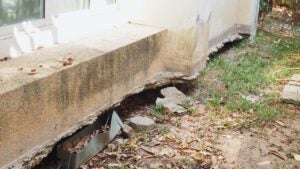The verdict is in: Third-party litigation funding contributes to high home insurance rates

The insurance industry is in the midst of another crisis, but until recently, this one was flying under the radar. Many insurance companies have been reporting record losses while insurance premiums for many consumers have reached astronomical levels. Why are we paying so much more for insurance even though firms are still going belly up? One key reason: third-party litigation funding has become a billion-dollar money-maker for lawyers and insurance companies—and policyholders are paying the price for rising litigation.
Insurance companies are fending off more lawsuits than ever before, which eats into profits and causes insurance rates to skyrocket. It’s a complex situation fueled by SEO manipulation and advancements in technology, but there are ways policyholders can avoid falling prey to the dubious legal practices that drive prices up for all of us.
What is litigation funding and how does it impact the insurance industry?
Third-party litigation funding (TPLF), also known as litigation finance, is when a person or entity who is not involved in a legal case provides money to support the case. In return, they receive a portion of the settlement if the case is successful.
There are many pros and cons to litigation funding, but it generally boils down to two distinct points of view. One side says it levels the playing field between David and Goliath. The average person does not always have the financial means to pursue a legitimate lawsuit or afford the best legal representation. Litigation funding can provide the plaintiff with access to money immediately, which they may need if they are displaced, injured or out of work.
However, this legal help can come with a hefty price tag. Attorney fees are typically 33 percent of the settlement amount, and with litigation funding, investors can add additional interest to any money the plaintiff received during the trial. Some contracts may allow investors to decide if a case should continue or be settled, requiring the plaintiff to relinquish control of the case. Investors and hedge fund managers want to make good on their investments, which might not align with your needs. Potential plaintiffs may want to carefully review the terms of their agreement before working with a TPLF company.
Litigation funding has been happening for years, but with the development of legal operating platforms programs, it has turned into a billion-dollar industry. According to Research Nester, the litigation funding investment market may exceed 50.3 billion by the end of 2036.
Legal system abuse in insurance is fueled by SEO manipulation
“They put it in the guise of ‘we want to help you,’ but they are there to make money,” says Todd Kozikowski, CEO of data analytics and risk assessment firm 4WARN, explaining how this all comes together to hurt policyholders. Opportunists, as he calls them, use natural disasters and catastrophes to drive their business model. By using black-hat techniques like cloaking, keyword stuffing and hidden text, new websites pop up seemingly overnight, outranking established and legitimate insurance carriers.
Why does ranking on Google matter? Because only 0.63 percent of people click on the second page of Google when looking for information. “Negative SEO,” as Kozikowski and 4WARN co-founder Joe Petrelli call it, alters the user’s search intent. For example, if you Google the word cat, you should see pictures of cats, not dogs dressed as cats. But in this case, people may Google something like “claim phone number for XYZ insurance company” which will return “file your XYZ insurance claim here with ABC law firm,” as a result instead.
Kozikowski and Petrelli witnessed this in real-time during the Maui wildfires. Several sites advertising ways Maui wildfire lawyers can help with insurance claims popped up online within 48 hours of the fires starting. Lawyers who weren’t authorized in the state to practice law arrived in droves to file lawsuits, all while the fires were still active and residents were being evacuated to safety.
The rise of legal system abuse in Florida
Florida has long been the testing ground for how home insurance companies and government agencies handle extreme weather risks and state policy. When laws in Florida change or carriers leave the state, other states and companies tend to watch closely to see the impact of these actions. According to Petrelli, it is also ground zero for pushing the limits of opportunism into legal system abuse.
Petrelli founded Demotech, an independent financial ratings firm, in 1985. His company has been the primary rating agency in Florida since 1996, and as of 2022, is registered with the U.S. Securities and Exchange Commission as a nationally recognized statistical rating organization (NRSRO). When six Florida insurance carriers, seemingly in good financial health, went insolvent in 2021, this signaled to Petrelli that something was wrong.
“They were litigated to death,” he says. Upon a post-mortem examination of the failed companies, he discovered that the rapid increase of new litigation was too much for these carriers to withstand. One example he gives is that of St. John’s Insurance. According to Petrelli, St John’s typically had around 180 lawsuits per year. But between 2017 and 2021, new cases grew to 3,508 per year. “We knew this had to be more than billboards. This had to be more than door knocking. It was an escalation of unprecedented proportions.”
Petrelli reached out to Kozikowski, a self-declared “data guy” with extensive experience in analytics and machine learning. Kozikowski discovered professionals operating on the outskirts of the insurance industry were using new digital tools and various marketing techniques to divert policyholders away from carrier sites and drive up lawsuits against insurers.
For example, he found that one public adjuster in Florida was spending over $650,000 per year on SEO keyword marketing related to insurance and catastrophic storms. Upon further investigation, he found that one national law firm paid $861,000 monthly on SEO strategy. The more Kozikowski researched, the more he uncovered groups and individuals using technology to target insurance companies with funding from litigation investors.
Extreme weather makes policyholders easy targets
What makes states like Florida and Louisiana so susceptible to this situation is their vulnerability to predictable extreme weather events. From June 1 to November 31, homeowners along the Gulf of Mexico and the East Coast track every named storm announced by the National Oceanic and Atmospheric Administration (NOAA). But they aren’t the only ones. Once NOAA names a storm, opportunists spring into action and create misdirection.
“You need a claimant’s name, a policyholder,” says Kozikowski, in order to file a lawsuit. And this is what opportunists spend millions of dollars a year on — easy access to your information.
When you try to file a claim online in a targeted area, there is a good chance you are repeatedly directed to law firms or bombarded with ads about how you will only get a fair claims payout if you sue your insurance company. For example, if you happen to file a claim on a spoofed website for “Travellers” instead of “Travelers,” a “claims agent” readily takes your information. (Kozikowski and Petrelli confirmed that a law firm was willing to pay $10 per click for Travellers with two l’s).
Once the law firms have your information, they can contact your insurance company on your behalf to set up a lawsuit. As a rule, once you file a lawsuit against your insurance provider, you can no longer speak to them; all communication goes through your attorney. So, if you happen to call your carrier to check on your claim, they will likely direct you to your attorney, who already has all of your information.
From there, some policyholders may stand firm and investigate the situation. However, others, especially homeowners who are in dire situations or who have never filed a claim before, may just assume this is the natural process and go along with it.
Opportunists are utilizing not only the natural disaster, but they’re using the fragility of the family situation as a lever to deceive them.— Joe Petrelli, Demotech founder
Americans bear the burden of tech-enabled litigation claims
What makes these tactics particularly disturbing to Petrelli and Kozikowski is that they are preying on people in crisis. Families are displaced, property is lost, and when they reach out to their insurance company for help, they are getting duped. Petrelli explains: “People who use an attorney or public adjuster when they have a total loss; the attorney and public adjuster take their fee out of that total loss, so the policyholder is no longer in a position to do the repairs.”
The litigation process is long and arduous. Oftentimes, homeowners get less than what they need. “It can take years for these claims to work through the courts. After inflation and fees, how much are policyholders really left with?” says Petrelli.
Litigation platforms allow law firms to search court documents and policy provisions for weak language, giving them the opportunity to file lawsuits en masse. Morgan & Morgan, a law firm located in Orlando, Florida, managed to file 25,000 cases in just six days — right before HB 837, Florida’s new tort reform bill eliminating one way attorney’s fees and fee multipliers, went into effect.
The end result of more claims and increased litigation is a significant increase in social inflation, a term referencing rising claim costs that surpass the effects of economic inflation, and higher insurance costs. Insurance rates are based on risk. The insurance market tends to be stable when insurance companies can predict and price risk. However, the fast-paced and unpredictable nature of tech-enabled claim instigation and legal system abuse, on top of increasing extreme weather claims, makes it difficult for carriers to price this moving target.
“A contested claim costs three or four times more than a regular claim,” says Petrelli. “Until we get the litigation under control, there’s not going to be rate stability for consumers. Investors are loaning money to these law firms because the business model of fooling people online works.”
Is digital ambulance chasing illegal?
Matt Monson, ESQ., founder and manager of Monson Law Firm, is concerned about the next phase of legal system abuse, one he calls “litigation harvesting.” Lead generators send targeted text messages to the public in an effort to create class action lawsuits and increased claim cases. After just a couple of clicks and a short phone call, people are enrolled in a lawsuit completed with a signed contract, without ever speaking to an actual lawyer.
The lead generators will then sell your information to the law firm, which, depending on what state you live in, may be considered improper attorney solicitation, otherwise known as ambulance chasing.
“Under attorney advertising rules, which vary from state to state, people are supposed to call attorneys. That’s why there are so many attorney billboards. The billboards are meant for you to contact them, not the other way around,” says Monson. Ambulance chasing, or barratry, is considered unethical behavior according to the American Bar Association (ABA), Rule 7.3. About 17 states specifically outlaw this behavior, including Florida, Texas and Louisiana.
“Ambulance chasing is not allowed,” says Monson. “I can’t knock on your door after a big weather event and ask if you have damage. What is the difference between the phone being your door, and the text being the knock?”
This was one of the tactics used by McClenny, Moseley & Associates (MMA), a law firm based out of Texas. In 2021, MMA moved into Louisiana and conducted the largest insurance fraud scheme in the state’s history. Between mass texts and SEO manipulation, MMA was able to sign up 15,000 clients in record time—many of whom were unaware of having any kind of attorney repression.
Policyholders who have waited for years for their claims payout remain in financial limbo. MMA collected at least $20 million from insurance companies without passing it on to their “clients” and now these funds are inaccessible. While this case is still ongoing, MMA is barred from practicing law in Louisiana.
Everybody pays property insurance, even if you are a renter, it is getting passed on to you. There’s no escaping this. Millions of people are paying thousands of dollars more than they should, so a handful of people can make millions.— Matt Monson, ESQ. Monson Law Firm founder
How you can protect yourself from opportunists
Here are a few strategies policyholders can employ to ensure they’re not inadvertently getting taken advantage of during the claims process:
- Contact your insurance company directly: When it is time to file a claim, use the contact information provided in your policy documents. To avoid web searches that can leave you vulnerable to false information, save your insurance company’s service and claims number in your phone.
- Keep your carrier’s mobile app updated: Many insurance companies allow policyholders to buy policies online and file claims through the mobile app without ever speaking with an agent. Apps are more secure when they are regularly updated directly from your phone’s app store.
- Work with an agent you know: Building a trusting relationship with a local agent or broker can help lower your risk of falling for a false representative.
- Beware of people who approach you after a loss: In most cases, you will call your insurance company at the time of a loss, not the other way around. Lawyers, roofers, contractors and others in the insurance industry who approach you after a public catastrophic event may not be who they say they are.
- Slow down: Before you sign anything, slow down and make sure you understand who you are speaking with and what you are agreeing to.
Insurance companies are not blameless in this situation. There are cases where an insurance company can be stingy with claim payouts and policy language is not written in a way that most people truly understand. This leaves carriers and policyholders open to opportunists, and now we can see how much that costs all of us. Lawsuits will happen, but they should be rare and occur after the claims process has run its course and the policyholder is unsatisfied with the outcome, not a litigation firm.
Editor’s note: This article was updated to clarify that some contracts allow investors’ influence in third-party litigation funding cases. A contract may vary depending on the specifics of the TPLF agreement.
You may also like

Does homeowners insurance cover foundation repair?

Can lawmakers save the collapsing Florida home insurance market?

Surprising things your homeowners insurance covers



